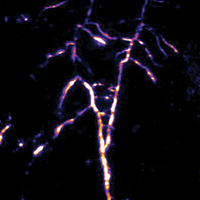
Gage Lab
Dept. of Molecular and Cell Biology
University of Connecticut - Storrs
Research-Rhizosphere_Microbiology
Understanding microbial effects on soil and rhizosphere
Identifying types, and distributions, of nutrients found around plant roots is needed in order to better understand forces driving plant/microbe interactions. However, nutrients near the root are difficult to study: they are hard to extract from soil, they are readily used by microorganisms and thus rapidly disappear, and it is difficult to sample the root region without disrupting nutrient distributions. We have overcome some of these problems by constructing and deploying bacterial reporters which fluoresce, or produce light via the Lux proteins, when particular nutrients are present in the root/soil environment. The locations of fluorescing, or light emitting, bacteria indicate regions where particular nutrients are detected by the biosensing bacteria. Using this technology, nutrients and their locations in time and space can be observed around plant roots, and in soil. In addition, we are using microfluidics and light inducible gene expression to control bacterial exopolysaccharide systhesis and understand how it influences soil structure and water retention. This work is multidisciplinary and is being done in collaboration with Dr. Zoe Cardon at the Marine Biology Lab at Woods Hole, Dr. Leslie Shor, Dr. Yongku Cho and Dr. Jessica Furrer.
Selected papers - Rhizosphere

Tomato roots inoculated with bacteria that produce light when growing quickly. Colored areas indicate that conditions are capable of supporting rapid bacterial growth (see Herron et al.)
Guo Y-S, Furrer JM, Kadilak AL, Hinestroza HF, Gage DJ, Cho YK and Shor LM (2018). Bacterial extracellular polymeric substances amplify water content variability at the pore scale. Front. Environ. Sci. 6:93. doi: 10.3389/fenvs.2018.00093 get pdf
Deng, J., Orner, E. P., Chau, J. F., Anderson, E. M., Kadilak, A.L., Rubinstein, R. L., Bouchillon, G. M., Goodwin, R. A., Gage, D. J. and L. M. Shor. (2015). Synergistic effects of soil microstructure and bacterial EPS on drying rate in emulated soil micromodels. Soil Biology Biochem. 83:116-124 get pdf
Herron, P. M., Gage, D. J., Arango-Pinedo, C., Haider, Z. K., and Z. G. Cardon (2013). Better to light a candle than curse the darkness: illuminating spatial localization and temporal dynamics of rapid microbial growth in the rhizosphere. Frontiers in Plant Sci. Article 323. get pdf